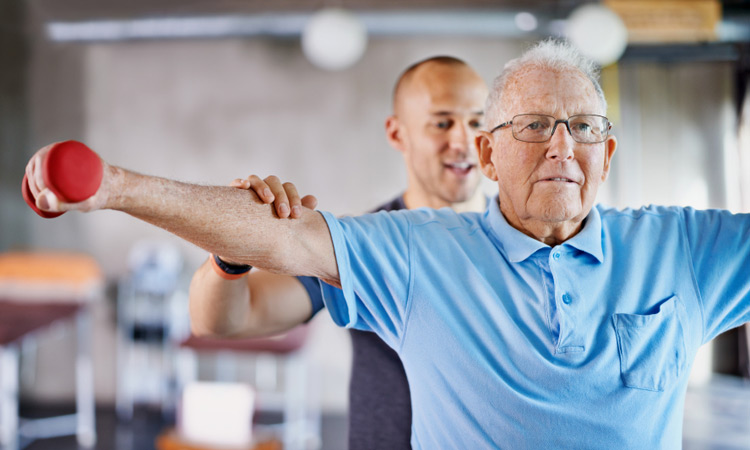 Falling is the leading cause of emergency room visits for all age groups in the US and a leading cause of unintentional death for people middle-aged and seniors. Long hospital stays, high medical costs, lost wages, intense pain and suffering all frequently result from falls. But new evidence suggests that beginning certain types of exercise programs as early as middle age can prevent falls, and even serves as early prevention later in life.
Falling is the leading cause of emergency room visits for all age groups in the US and a leading cause of unintentional death for people middle-aged and seniors. Long hospital stays, high medical costs, lost wages, intense pain and suffering all frequently result from falls. But new evidence suggests that beginning certain types of exercise programs as early as middle age can prevent falls, and even serves as early prevention later in life.
Enhance Fitness (EF) is a highly successful, evidence-based exercise program. Originally developed by the University of Washington to prevent disability in seniors, EF is now monitored by the Center for Disease Control (CDC). After six months, EF participants showed 35% improvement in physical function. Over half the states now have EF classes at one or more locations.
A recent CDC study involving EF participants says, “The results of this analysis provide evidence that participation in EF is associated with a reduced risk of medical falls.”
The CDC concludes, “Overall, results suggest that evidence-based physical activity programs, particularly EF, should be more widely disseminated into communities not only for their general effects on fitness but also for their likely benefits on prevention of fall-related health care use, an important personal and societal outcome.”
What you can do
Certified EF instructors conduct EF classes, test the participants, monitor their initial ability and progress, and report findings to the CDC. The program is dependent upon consistent attendance, usually for one hour, three times per week. Classes consist of roughly a half-hour of aerobic exercise and a half-hour of weight training—with balance exercises throughout—and a brief warm up and cool down. The exercises can be done entirely in a chair or partially standing.
Mikael Anne Greenwood-Hickman, leading author of the CDC study on reducing falls with EF, told Rewire Me the key components in the EF program for fall reduction are strength and balance training.
Brian Werner, PT, MPT, and national director of balance center programs at FYZICAL—a national physical therapy franchise—explains that many people are missing the balance component of their exercise programs, a important part of EF.
Exercise matters
Research supports the idea of people in middle age using EF as a model for preventing falls into their senior years.
As Greenwood-Hickman described, “Generally speaking, the earlier such a regimen is started and the longer it’s continued, the more effective it would be.” Following that logic, Greenwood-Hickman believes younger people who devote time to strength and balance training as part of their regular physical activity could reduce their risk of falls, currently, and in later life.
A study from the Center of Epidemiology supports Greenwood-Hickman’s theory about early prevention. The researchers explained, “Given the trends toward increased sedentary behavior as worksites, homes, and public spaces have been evolving in ways that minimize human movement and muscular activity, (citation omitted) more investigation into the role of physical activity in protecting middle-aged adults from falls is needed.”
As a physical therapist, Werner understands how changes in lifestyle affect balance. “The number one cause of balance loss is mobility,” Werner says. “In older people, it’s often co-morbid issues like heart disease or diabetes. But in younger people, it’s our success with our jobs and our families that keeps us sedentary.”
The Center for Epidemiology study also found, “The results have important implications for prevention efforts in middle-aged adults.” Specifically, researchers suggested, “Improved muscle strength training, balance, proprioception development, and maintenance via (leisure time physical activity) during middle-aged adulthood may be carried over when the individual gets older, and it may also aid in the reduction of falls and fall-related injuries in older adulthood.”
According to a John’s Hopkins study, 35% of Americans above the age of 40 have a balance deficit. But in the initial stages, this can be difficult to detect. Many are asymptomatic for years, and it often goes unaddressed, explains Werner. “People don’t perceive balance as something you can improve.” But he insists you can. “You challenge it.” A new movement in physical therapy promotes wellness and prevention.
In most communities you can find numerous options for balance and mobility training, such as yoga, tai chi and Pilates. Dance classes, martial arts and other programs combined with strength training can serve the same purpose. Personal trainers are also available at most gym facilities to help you design a program with the fundamental concepts of challenging balance and mobility and strength training to help prevent falls now and into your future.
Click here to find out about Rose’s thoughts on wellbeing and health


